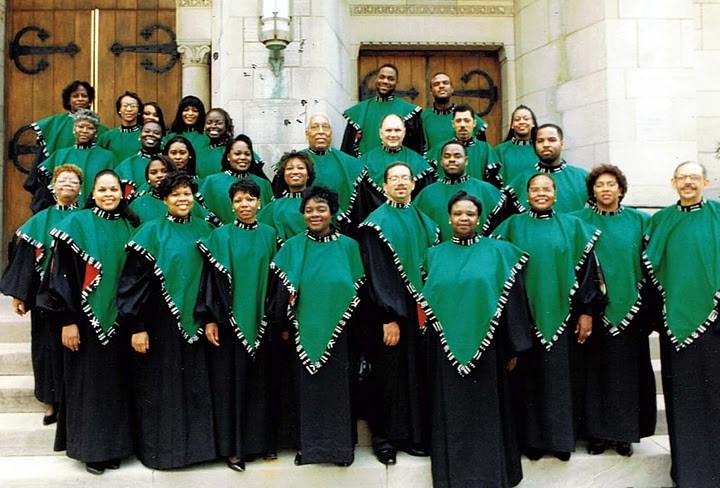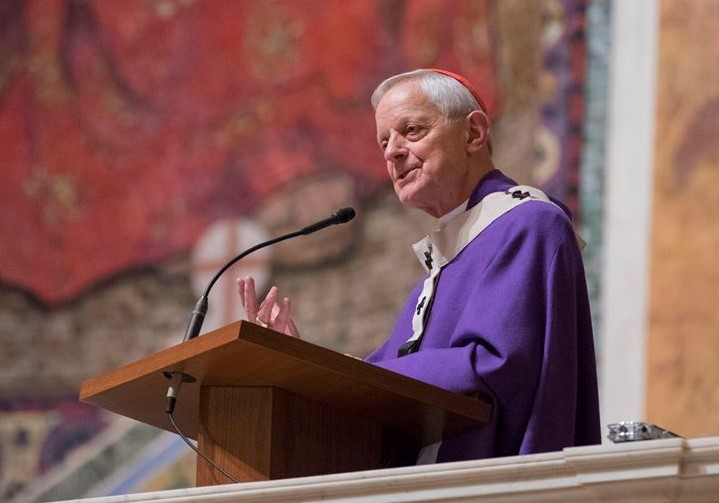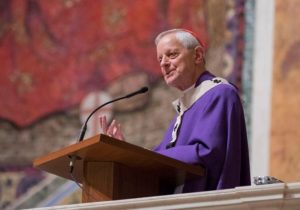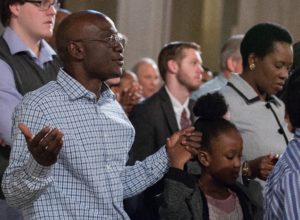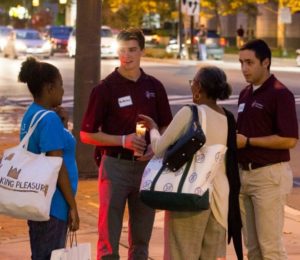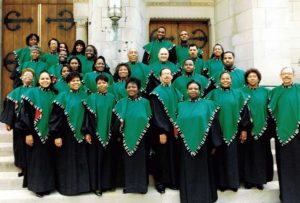 February is African-American History Month. Most of you who read here regularly know that I’ve spent most of my 28 years of priesthood ministering in African-American parishes here in Washington, D.C. (At right is a picture of our choir.)
February is African-American History Month. Most of you who read here regularly know that I’ve spent most of my 28 years of priesthood ministering in African-American parishes here in Washington, D.C. (At right is a picture of our choir.)
In recent years, my own parish has become more racially and ethnically diverse, but we are still deeply rooted in the long African-American heritage here and we celebrate that in particular at our 11:00 AM Sunday Mass. It is a heritage that retains deep roots in the sacred and draws richly upon the biblical norms of trust, liberation from sin, justice, and the lively experience of God’s immanent presence.
I would like to share a few of the things I have learned and experienced over the years, focusing primarily on the liturgical experience. Despite the inadequacy of my words in describing it, I hope that you will grasp the rich wisdom and sacred tradition that I have been privileged to experience. I do not claim that what I write here is true of every African-American Catholic nor that the values I describe below are wholly lacking elsewhere, but just that they are widely held in the community.
Expectation – Great expectations are brought to the liturgical moment. Most of my parishioners come to Mass expecting to be moved, changed, and transformed. It is expected that God, the Holy Spirit, will show up and that He will do great things. Prior to Mass there is an air of anticipation as the parishioners gather. Some call this “The Hum.” The expectation is palpable and parishioners both want and expect a deep experience of God. They look forward to the songs of praise that are about to be sung and are prayerfully expectant of a good sermon through which they will “get a word” from the Lord. There is little anxiety about time and there is no need to rush. This is God’s time and He is about to go to work.
All about God – Gospel music (traditional and modern) is a central facet of most African-American parishes, but a wide variety of music is sung, including spirituals, traditional hymns, and classical music. One of the glories of the musical repertoire in African-American parishes is that it is almost exclusively focused on God and what He is doing. I have remarked in the past that much modern music is far too focused on us, who we are, and what we are doing. Not so in the gospel music tradition, in which God is invariably the theme. In an anthropocentric time, this is a refreshing stream from which to draw. Regardless of your feelings about the style of gospel music, it is about God. One song says, “God is a good God, He is great God, He can do anything but fail.” Another song says, “God and God alone!” Yet another says, “God never fails!” Even when we mention ourselves it is only to remember God: “We’ve come this far by faith; Leaning on the Lord, trusting in his holy word, He’s never failed me yet!”
Primacy of Joy – A serene and joyful spirit is at the heart of African-American worship. The Church is a bride—not a widow—and God is good! Even in difficult times we ought to praise the Lord. Psalm 34 says, I will bless the Lord at all times, his praise shall continually be in my mouth. An old African-American spiritual says, “Praise the Lord anyhow!”
Joy is manifested in many ways in African-American worship: clapping, stepping, and swaying during the singing, uplifted hands, spontaneous acclamations—even an occasional stamping of the foot!
It is a strange thing if a Catholic Mass looks less like a wedding than a funeral: sour faces and boredom. To be sure, people manifest piety in different ways. Even in African-American parishes not everyone is on his feet as the choir sings powerfully. However, it is right to manifest some glimmer of joy rather looking like we just sucked a lemon!
Joy is a great gift and it is present in abundance in African-American worship. St. Paul says, Rejoice in the Lord always, again I say it, rejoice! Your graciousness should be known to all (Phil 4:4-5). A gospel song says, “Joy, Joy, God’s great joy. Joy, joy, down in my soul. Sweet, beautiful, soul saving joy, oh, joy, joy in my soul!”
Time – This is God’s time. Earthly time is largely suspended in the African-American experience of the Mass. Masses are often substantially longer than those at most Catholic parishes. At the African-American parishes where I have served, the “High Mass” lasts up to two hours.
In most Catholic parishes there is an unwritten rule that Mass should be between 45 minutes and an hour long, and sermons should be less than 10 minutes long. Some of the Masses here are an hour or less, but not the Gospel Mass, where time is more relaxed. It may be that the Holy Spirit inspires a soloist to take up the refrain of a song yet one more time. There’s often an expression that comes from the congregation: “Take your time,” or “Sing on!” This is God’s time and He will do what He will do.
Most African-American congregations are also famous for lingering after the service. Another expression comes to mind: “Take your time leaving.” Mass is one of the highlights of the week; why rush through it? Savor the moment. A song says, “We’re standing on holy ground.”
Creativity and Freedom in the Spirit – African-American Catholic worship is careful to follow the norms for Mass but exhibits an appreciation for creativity and for docility to the Holy Spirit. This is especially evident in music. It is rare that a soloist sings the notes of a song exactly as written. (The exception to this would be when classical music is sung). Rather, liberty is taken as the choir, soloists, organist, and director are all open to what and where the Spirit leads.
There is deep appreciation for this spontaneity; it is seen as a manifestation of the Holy Spirit interacting with the gifts in the community. A gospel song says, “Over my head, I hear music in the air. There must be a God somewhere!” There is also a history to this that stretches back to slave times. Those who were enslaved enjoyed very little freedom, but on Sundays they would gather in secluded locations. They would often take up the hymns they had heard from the European tradition but adapt them. In so doing they expressed their freedom in the Lord. The spirituals, too, are remarkably creative, manifesting a genius of both word and song. They also admit of a wide variety of interpretations; different verses are swapped in and out at the will of the singers.
All of this creativity leads to a great expectation in the liturgy. Who knows what God will do? There are moments of great delight and a sense that this is all in God’s hands.
It also gives a different understanding to the presence of applause in the liturgy. Many rightly lament that in certain settings applause creates the notion of performance rather than worship, but in the African-American setting applause is an act of praise to God, thanking Him for this manifestation of the Spirit. This is made evident by the fact that the congregation most often applauds even after the songs that it sings together. This is not self-congratulation; it is an act of praise to God. The psalms say, Clap your hands, all you nations; shout to God with cries of joy (e.g., Ps 47).
The Preaching Moment – Sermons are typically longer in African-American Parishes. At the High Mass, the sermon is usually half an hour. The congregation has great expectations for the homily and there is a great interest in spending time with the Word of God. It is expected that the preacher will not only seek to inform the congregation but to celebrate the liberating reality of the Word that is proclaimed. The Word of God does not just inform, it performs and transforms. The preacher is invited and expected not just to preach the “what,” but also the “so what” and the “now what.”
These expectations have challenged me over the years to be aware of the majesty of God’s Word, to look deeper into its meaning, and to experience its truth and reality in my life. Only then can I really preach with the power and authority that God’s Word deserves.
With more time, there is the luxury of really digging into a passage and analyzing all the lines. Many of you who read this blog have read my Sunday Sermon outlines and note that I usually break open the whole text rather than just draw out one thought or idea and preach that. The longer format permits the preacher to examine the steps often set forth by a gospel passage and to follow the passage line by line. This is a great luxury for me.
I am not alone in the preaching moment. One of the glories of the African-American preaching tradition is that the congregation has a central role in the preaching moment. It begins with their expectation. I know that they are praying for me and are supporting me as I begin. They really want to hear a word and spend some time with it. This is a moment to be savored.
The priest or deacon will often engage the congregation by taking up the tradition of “call-response,” wherein he elicits a familiar response from the congregation and invites acclamations: “Somebody say, Amen.” “Amen” “Is there a witness in this house?” In this way he builds on the theme and involves the congregation.
The congregation also takes a role in crafting the homily moment through spontaneous acclamations: “Amen!” “Go on, preacher!” Help him, Lord.” “Make it plain, preacher!” There can be spontaneous applause and shouts as well as laughter and even some oohs and aahs.
Jesus is Here Right Now – In African-American Catholic worship there is a profound sense of the presence of the Lord Jesus Christ in every liturgy. Most traditional Anglo-Saxon Catholics prefer to express their faith in the true presence through silent adoration, bowed heads, and folded hands. The African-American tradition, though not excluding such forms, expresses this faith through exuberant joy in the Lord’s presence and cultivates a celebratory experience that this is holy ground, that this is the Lord’s house and He is here. Songs during Communion include texts that acknowledge this in more experiential and immanent than theological and transcendent ways. There are songs with words such as these: Jesus is here right now, I received the Living God and my heart is filled with joy, Now behold the Lamb, Taste and see the goodness of the Lord! Come now and feed our weary souls.
Permission – To think that every African-American likes only gospel music, wants to shout out during homilies, and gets excited at Mass, is to stereotype. There is a whole range of personalities expressed and experienced at Mass. Some people are exuberant and expressive, others quiet and reserved. A wide variety of preferences and liturgical expressions exist.
What makes African-American worship diverse and expressive is the concept of permission. Not everyone is required to clap rhythmically at songs, but there is the permission to do so. Not everyone responds during homilies but one may. Not everyone gets to his feet as the choir sings powerfully, but there is permission to do so. There is a wonderful combination of permission without pressure.
Trust – A key theme of African-American culture is trust in God. This has come not only from a long history of oppression but also from the experience that “God can make a way out of no way” and “do anything but fail.” Gospel music and the spirituals are replete with calls to a trusting and confident faith. Here are some examples from various songs: “God never fails.” “Blessed Assurance!” “Victory is mine.” “Whatever my lot thou hast taught me to say It is well with my soul, it is well.” “Joy comes in the morning; troubles don’t last always.” “He may not come when you want him, but he’s always on time.”
These songs of trust and assurance were very important for me in my 35th year of life when I suffered a nervous breakdown and slipped into a major depression, complete with anxiety attacks. This parish literally helped to sing me back to health.
Sober about Sin and Confident of Grace to Overcome – Good, solid, biblical preaching is appreciated in the African-American tradition. It is understood that the Lord has a lot to say about sin that is plain and unambiguous.
There is also a legacy of gospel music and spirituals that speaks frankly but creatively about sin and its relation to redemption. Here are some excerpts from songs: “I once was lost in sin but Jesus took me in.” “I was sinking deep in sin far from the peaceful shore. Very deeply stained within, sinking to rise no more. But the Master of the sea heard my despairing cry and from the water lifted me. Love lifted me. When nothing else could help, love lifted me.” “I would not be a sinner; I’ll tell you the reason why. I’m afraid my Lord might call my name and I wouldn’t be ready to die.” “Satan wears a hypocrite’s shoe. If you don’t watch he’ll slip it on you.” “Some go to church for to sing and shout, before six months they’s all tuned out.” “Where shall I be when the last trumpet sounds?” “Sign me up for the Christian jubilee, write my name on the roll. I want to be ready when Jesus comes.” “I’ve got to fast and pray, stay in his narrow way, keep my life clean each and every day. I want to go with him when he comes back, I come too far and I’ll never turn back!”
So sin is real but so is grace to liberate us. One song says, “I’m not what I want to be but I’m not what I used to be, a wonderful change has come over me.”
These are just a few of the many lessons I have learned from my parishioners over the years. As you can see, African-American Catholics have important gifts to share with the wider Church. I want to be sure to express my gratitude for this gift of culture and tradition and for the gift that every parishioner has been to me. I have learned far more than I have ever preached. I have come to know by experience that encountering Christ does not just happen from the priest to the faithful, but also from the faithful to the priest. We observed the birthday of Dr. Martin Luther King, Jr. last month. Birthdays celebrate the gift of human life and the gift of each human person. I have much to celebrate.
I realize that not everyone prefers the relaxed exuberance described here; some are more partial to quieter and more traditional forms. I have celebrated the Traditional Latin Mass for almost 30 years and appreciate its beauty as well. Today the Church allows greater diversity; what I set forth here, at the beginning of African-American History month, is that I have been blessed and enriched in this tradition, as I have in others. May God be praised.

